The Bathing Suit
One of the first specialized sports garments to be developed was the bathing suit. As the popularity of seaside visits increased, so did the popularity of "bathing." In the first half of the 19th century, beaches had either separate sections for men and women, or they had some hours designated for men and others for women. In Europe, a dressing room on wheels (called a bathing machine) was being used, in which women changed into a long, heavy chemise-like garment, were wheeled out into the water, and then were lifted out into the water to bathe. These machines were introduced into America, but did not really catch on. In time men and women began bathing together at American beaches.
About the time that Amelia Bloomer came out with her reform costume, a very similar bathing costume began appearing in fashion magazines and on American beaches. I think it is too much of a coincidence not to conclude that the bathing suit was directly influenced by Mrs. Bloomer's costume.
from the collection of the Seneca Falls Historical Society
Originally, the swimming bloomers reached the ankles, and the overdress was a few inches above, but as the 19th century progressed, both bloomers and dress got shorter. Still, the wearer wore black stockings and bathing shoes or boots, along with a cap and sometimes even gloves. Until the 20th century, many women actually wore a corset beneath her bathing suit.
An 1870s fashion plate
At first glance, 19th century bathing suits do not seem to follow fashion, but there were concessions . As short sleeves on dresses became fashionable, the bathing suit also sported short sleeves. Skirts narrowed after 1875, and so did the bathing dress. And the introduction into the US of British and French bathing suits (which were not as modest as those in the US due to continued separate sex bathing) caused the dress and bloomers to join into one piece and to be shortened to the knee.
Edwardian bathers at the shore
The 19th century bathing suit was usually made from dark colored wool, though vintage fashion plates and photos sometimes show them in white or light colors. Because of modest concerns, light colors were not often used, as the water tended to make them a bit transparent. By the end of the century, the typical bathing suit was black or navy, decorated with white of red braid, and often had a nautical look, the blouse being fashioned after a sailor's middy blouse.
<img src=
http://fuzzylizzie.com/myPictures/swimphotos/atlanticity2.jpg>
An Atlantic City studio shot, c, 1908
20th Century Bathing Suits
As Americans moved into the new century, the bathing costume remained pretty much unchanged for another decade. But as the 1910s progressed, several things led to a shrinking of the suit. As more and more people had the time and means to visit beaches and swimming areas, suntanning became fashionable. For some time men had been wearing bathing suits made from wool jersey knit. In the 1910s women who swam competitively adopted men's suits that were sleeveless and which had a short skirt attached over the legs of the suit.
<img src=
http://fuzzylizzie.com/myPictures/swimsuits/plaidswimcap.jpg> <img src=
http://fuzzylizzie.com/myPictures/swimsuits/swim11.jpg><img src=
http://fuzzylizzie.com/myPictures/swimsuits/swimboots.jpg>
This suit was trademarked 1911. It's the "Swim-easy."
By 1918, women's bathing suits were usually sleeveless and were considerably above the knee. A woman could buy a jersey knit bathing dress with attached shorts, or the dress might be made from woven wool or silk and have a ruffled skirt.
<img src=
http://fuzzylizzie.com/myPictures/swimsuits/20sbathingcap.jpg><img src=
http://fuzzylizzie.com/myPictures/swimsuits/1920suit.jpg><img src=
http://fuzzylizzie.com/myPictures/swimsuits/bathingshoe 002.jpg>
Late teens or early 20s suit with accessories
Either way, the swim dress was much smaller, and it continued to shrink throughout the 1920s. By the mid 20s women were wearing suits very similar to those worn by men - a one piece knit tank and trunks with an overskirt.
<img src=
http://fuzzylizzie.com/myPictures/swimsuits/swimred.jpg>
A late 1920s suit
In the 20s, the swimwear industry was booming, and several companies saw an opportunity and seized it. Knitwear companies that had been making sweaters, underwear and knit gloves changed over to making swimwear. It was during this time that swimsuit giants Catalina, Cole of California and Jantzen were born. All three companies were located on the west coast of the US, and this helped establish that area as a leader in the sportswear industry.
By the 1930s, the overskirt was going and around 1932, men started going "topless" for the first time. Swimsuits were still being made from wool, and there were some serious fit issues, as the wool lost elasticity when wet. This problem was solved with the introduction of Lastex in the mid 30s. The elastic fibre was used first in wool knit blends but soon woven fabrics were developed using it. The woven fabrics, similar to those being used in the making of corsets, soon made the old woolen knit suits passe.
<img src=
http://fuzzylizzie.com/myPictures/swimsuits/jantzen30s 001.jpg> <img src=
http://fuzzylizzie.com/myPictures/swimsuits/jantzen30sad.jpg>
1936 Jantzen suit, wool with Lastex and a photo from an ad for it. This type suit was on the way OUT!
Because so much of the swimsuit industry was located near the film industry, it began to take on a glamorous air. Stars and Hollywood designers were used to advertise and promote the latest in swimwear. Hollywood stars showed their stuff in swimsuit publicity shots.
<img src=
http://fuzzylizzie.com/myPictures/swimsuits/catalina36.jpg>
1936 Catalina ad with Olivia de Havilland and Orry Kelly
In the late 30s and into the 40s swimwear began to diversify. The two-piece appeared around 1937, though it really did not gain acceptance until a few years later. Also bathing suits were starting to be made from "fashion" fabrics - popular prints and cottons formerly reserved for dressmaking.
<img src=
http://i41.photobucket.com/albums/e270/fuzzylizzie/swim2piece37.jpg>
A very modest 1937 2 piece suit
<img src=
http://fuzzylizzie.com/myPictures/swimsuits/swim40.jpg> 1940s dressmaker suit
During World War II, much of the swimwear industry was involved in the war effort, but there were some interesting developments. This was when the 2 piece suit really became popular. Due to fabric rationing, it became patriotic to sport less clothing while bathing. The US government mandated that bathing suits were to be made with at least 10% less fabric, and so the midsection was eliminated. Also, bra tops became fashionable for other casual wear, usually paired with cute wide legged shorts.
<img src=
http://i41.photobucket.com/albums/e270/fuzzylizzie/swim2piece45.jpg>
1945 2 piece swimsuits.
The bikini is credited to the French: designer Jacques Heim designed a very skimpy suit, the atome, in 1946. About the same time, Frenchman Louis Reard came up with an even smaller suit, the bikini.
Dorothea's Closet has a wonderful
early French bikini for sale.
As fashion moved into the New Look, so did the swimsuit. Many companies made swimwear that were styled very much like the evening wear of the period. And women who found the Baby Boom was taking a toll on their figures loved the structured lastex suits and the playsuit types that provided more coverage.
<img src=
http://fuzzylizzie.com/myPictures/swimsuits/swim50sbomb.jpg>
Lastex to hold you in ...
<img src=
http://fuzzylizzie.com/myPictures/swimsuits/plaidswim002.jpg>
Ruffles to cover you up!
Even though the Bikini was "invented" in France in 1946, it wasn't until the early 1960s that it became the swimsuit of choice for the young. Again, there was a strong Hollywood connection, as popular actors and actresses were featured in "Beach Movies."
<img src=
http://fuzzylizzie.com/myPictures/swimsuits/swim60.jpg>
Early 60s 2 piece swimsuit
By the mid 60s it was obvious the the swimsuit was going to shrink even further, although Rudi Gernreich's famous "topless" monokini never caught on with the general public. After the 60s, suits got smaller and smaller, until today one has the choice of a highly engineered suit that covers quite nicely - or a bit of string with three triangles that leaves very little to the imagination.
<img src=
http://fuzzylizzie.com/myPictures/swimsuits/swim70.jpg>
mid-late 60s bikini
I haven't gone into specific designers and makers mainly because this information is readily available on the Label Resource. Here are links to some of the largest swimwear makers, most of whom were located in California:
Alix of Miami
Bradley
<img src=
http://fuzzylizzie.com/myPictures/box/bradleybox 001.jpg>
From a Bradley box
<img src=
http://fuzzylizzie.com/myPictures/swimsuits/swimbard.jpg>
A late 1920s suit from Bradley
BVD
Catalina
<img src=
http://fuzzylizzie.com/myPictures/swimsuits/late50sswim3.jpg>
Late 50s Catalina suit
Cole of California
Deweese Design
Gantner
Jantzen
<img src=
http://fuzzylizzie.com/myPictures/swimsuits/jantzen.jpg>
An early 30s Jantzen suit
Rose Marie Reid
<img src=
http://fuzzylizzie.com/myPictures/swimsuits/rosereid001.jpg>
1950s Rose Marie Reid Bathing suit
And some sportswear designers who were also known for their swimsuits:
Louella Ballerino
<img src=
http://fuzzylizzie.com/myPictures/swimsuits/wsjantzenbates.jpg>
Louella Ballerino for Jantzen - 1946
Tom Brigance
<img src=
http://fuzzylizzie.com/myPictures/sports/brigancepattern.jpg>
Brigance Sewing pattern, 1950s
Rudi Gernreich
<img src=
http://fuzzylizzie.com/myPictures/swimsuits/rudi.jpg>
1959 Gernreich suit
Tina Leser
<img src=
http://fuzzylizzie.com/myPictures/leser/leser 001.jpg>
Tina Leser early 1960s swimsuit
Carolyn Schnurer
<img src=
http://fuzzylizzie.com/myPictures/schnurer/schnurerspringmaid3.jpg>
Carolyn Schnurer swimsuit, 1950 photo courtesy of Deja Vu Antiques
Alfred Shaheen
One last word about the early bathing suit: It is unique in the development of sportswear as it was the only public sport in which wearing "pants" was totally acceptable. In all other social sports, pants or bloomers were never universally accepted, though brave women wore them for Bicycling and skating. It was in "women-only" situations that pants began to be worn on a large scale until the 1910s when hiking knickers and riding jodhpurs caught on with women.




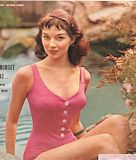

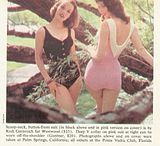



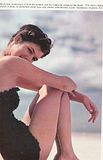
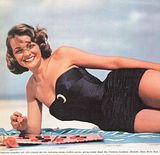

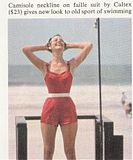
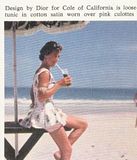













 Linda, do you mind if I save those Gernreich images? I'll need to find that issue. I have that suit!
Linda, do you mind if I save those Gernreich images? I'll need to find that issue. I have that suit!